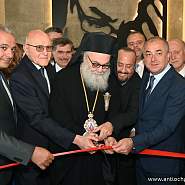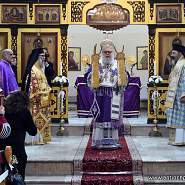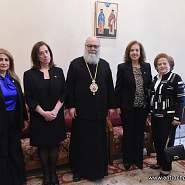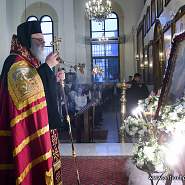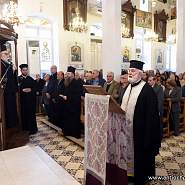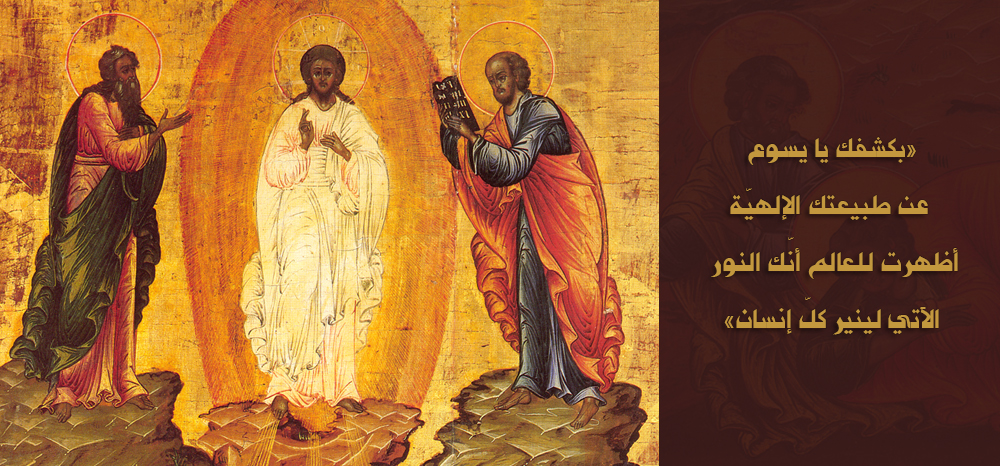
Detailed interpretation of Transfiguration
The three synoptic evangelists (Mathew, Mark, and Luke)
* The gospel of the feast
(Matthew 17: 1-9).
“And after six days Jesus took with him Peter and James and John his brother and led them u a high mountain apart. And he was transfigured before the, and his face shone like the sun, and his garments became white as light. And behold there appeared to them Moses, Elijah talking with him, and Peter said to Jesus, “Lord, it’s well that we are here, if you wish I will make three booths. One for you, one for Moses, and one for Elijah.” He was still speaking when lo, a bright cloud overshadowed them, and a voice from the cloud said, “This is my beloved son with whom I am well pleased; listen to him.”When the disciples heard this, they fell on their faces and were filled with awe. But Jesus came and touched them saying “rise and have no fear.” And when they lifted up their eyes they saw no one but Jesus only. And they were coming down the mountain Jesus commanded them, “tell no one the vision, until the son of man is raised from the dead.”(Matthew 17:1-9).
* Introduction & definition:
The Orthodox Theology emphasizes the uncreated light that came out of the Lord Jesus Christ on the mountain. This light was only his divine nature itself. He consequently explains that it is divine revelation, because our Lord Jesus Christ gathers in his person the divine nature and the human one, and both are
perfect in him. This divine revelation is called “metamorphosis”. The word is a Greek one, and means “to change form”, the prefix “meta”, “after” or “with”, sometimes even “beyond”. While the second part “morphe”, means “form”.
Christianity tries to look beyond what is visible, what is beyond the earthly element, towards Heaven. We are always called to start this change in our lives. It is a change in depth, and a sort of re-aiming at the target of our life; it is liberation from sins, and moving towards the Lord Jesus Christ. Metaneia which is translated into Arabic as “metaneia” is internal illumination and giving up the darkness of the fall, and re-taking instead the light we earlier had when we were created. This is exactly what the church sings and psalmodizes in the Orthros of the Feast; “Christ, when you wore the old Adam, you changed the nature that had been darkened, and made it shine out again, divinizing it by changing your image.”
Metaneia is total change in mentality, caring, and judging others, besides, it is deep longing towards repentance, supported by real struggle crowned by prayer, and patient continuous fasting. It is a call for real maturity, and longing for “theosis”, divinization (theosis) of the human nature by, the uncreated light of God, by the communion with him.
* History of the Feast:
The service of the Feast had been connected to a great extent, and according to liturgical history, and liturgical memory, with the consecration of the Basilica of Mount Thabor (the 4th and 5th centuries). The Feast had been celebrated before the exultation of the holy cross, because the celebration of the feast was formally in use after “the divine transfiguration”, the end of the 5th century and the beginning of the 6th. A piece of Mosaic belonging to the period was found in the apse of the
Basilica of st. Apollinarios in Ravenne, and in st. Catherine’s Monastery in Sinai Peninsula- Egypt.
The scene on the Icon of Transfiguration represents the basic evangelical event, but there are some details that were added later on.
St. John Chrysostom says that the transfiguration of the Lord took place 40 days before the resurrection of the Lord from the dead that is why the feast was localized on August 6, which is 40 days before the celebration of the holy Cross on September 14. And the link between the two feasts, strongly appears in the Catavasiai of the orthros of the holy cross that are chanted in the Orthros of the Feast (August 6).
The Vespers of the divine transfiguration begins pointing to the cross:” When you were transfigured Lord, the mountain looked like a sky. And the cloud was opened like a tent. And you were witnessed by the Father…..”
* Transfiguration and writing the Icon:
There is an old saying on writing an icon: “we need to mix the colors with the spirit itself, and with the shining light itself by which the world was created.”Holy, let’s be circled around your beauty.”
The Church emphasizes basically the initiation of man into the mystery of the uncreated light, the light of the transfiguration. This is why she demands of the one who wishes to write icons, to pray and fast before writing it (we say to write an icon and not to draw it, because the icon depicts evangelical scenes for instructions and evangelism, consequently the icon translates the theology of the event written on it). And every time the writer of icons intends to write an icon, the priest says a special prayer after some readings from the service of the
transfiguration, besides the troparion, and asks the lord to help him, as if he were saying:” with your light we write what is not written “. Then he lifts supplications to the mother of God, before her icon “the Hodigitria”, asking her to guide him in his work, and to lead him in the right path.
The theologian Paul Evdokimov says in the same context:” We do not write icons in colors, but with the light of Thabor which is the same light the holy apostles had seen on the mount of transfiguration.
This light-filled state is reflected in the icon as light and delight, consequently this activates the role of the Holy Spirit who makes its beauty surmount the beauty seen by the naked eye: This beauty is much further than mere color mixing. In this, the theological saying will come true. “The icon is a window to the kingdom.”
The Church also teaches that everyone who wants to learn the art of Iconography must first start with the icon of Transfiguration. And upon mastering the art, he can move elsewhere.
* Transfiguration is eternal indescribable light:
He was, is, and will be
“Transfiguration places us before a great positive contradiction. The Gospel describes what indescribable. The same thing is done by the icon of this feast. St. Gregory of Nyssa (335- 395) says on the vision of God by Moses: “Moses first met with God in the light, and the outcome was the inconsumable bush (Exodus 3). Then he had other meetings with God, and spoke with him in the cloud, yet he realized clearly that God cannot be seen (Exodus 33:20).
These instructions are also given through the Church dogmas: The divine essence is unattainable but man is divinized by the uncreated energy and light that come from above on man, and is inseparable from the divine essence.
Many Sts. Have experienced this in their relationship with God. And the Church did clearly express it in the 4th ecumenical Council (451) and the outcome was “apophatism” which denotes in fact the inability to describe and define, because God is above mercy and beyond light, he is even above Love itself.
The biblical text of Transfiguration shows the inability of man to define and describe the divine:” Six days after Jesus took with him Peter James and John and led them up a high mountain where they were alone. As they looked on a change came over Jesus and his clothes became shining white whiter than anything in the world could wash them .”(Mark 9:2-3).
The light shines from the Lord himself: His garments are of the resurrection, of the eruption of the divinity, and the emergence and resurrection of life which is the life of people.
Jesus is life:”In him life was and life was the light for people. The light shines in darkness and darkness do not put it out” (John 1:4).
The linguistic description is weak before the greatness of the Lord. He is incomparably brighter and whiter than whiteness itself, more brilliant than the beam of light, and more exquisite than glory itself. He is the source of all these.
He made these out of nothing. He is God, he was incarnated and became like us without losing anything of his divinity.
St John Chrysostom (349- 407) writes a dialogue with Mark the Evangelist, and makes it very detailed so as to include all the evangelists who spoke on Transfiguration.
St. John Chrysostom:
How was he transfigured?
Tell me
St. Mark:
With Majesty.
Chrysostom:
Why did you say: Like the sun?
You said like the sun, didn’t you?
Mark:
Yes
Chrysostom:
Why?
Mark:
Because I do not know about a planet that is brighter and whiter than snow.
Chrysostom:
Why did you say like snow?
Mark:
Because I do not know a thing brighter than snow.
Chrysostom adds saying:
It’s true, for if light were like the sun, and its whiteness like snow, we wouldn’t be able to explain why the apostles fell down while they were on the mountain. This falling down is real witness that our human nature couldn’t bear the energy and glory of the divine nature.
The apophatic theology is manifest in the icon of transfiguration, through the three circles behind the Lord, and they turn gradually from brightness into darkness, for darkness stands for the inaccessible, as if he were saying: The deeper we go into the knowledge of God (Theognosia), the more we find out that his essence is fathomless “who alone has immortality and dwells in unapproachable light, whom no man has ever seen or can see. To him be honor and eternal dominion Amen.” (1 Tim. 6:16).
The Holy Fathers warned scholars and researchers in theology and biblical matters against pride and arrogance, against the trap of the deadly pride, and against pomposity and ostentation, against making God out of speculations and intellectual analyses, whatever high and great are the researchers.
The rule is unchangeable, and has never been changed too:”with your light we see light.” This light is not acquired by being self-evacuated of any earthly haughtiness in order to be filled with the Holy Spirit. “It is Theognosia and not mere profane knowledge of God.
According to transfiguration, “light leads to light”, for Christ is light of light. This light is life, because our Lord is life, and this life is in the depth of every human heart, and we only have to dive into this depth to discover it. It is eternal life; the kingdom which we are called to,”the kingdom of God is in your heart” (Luke 17:20). It is an invitation to what is beyond the visible, an
invitation for the divine glory, if we can make the right choice:”Work for what is above, not for what is earthly.”(Col.)
St. Nicolas Kabasilas says:” If one is satisfied with what is external, he remains outside, because away from the light of Christ, there is only darkness”. And he adds:” in as much as one dives into the light of God, impediments recede and even disappear, only because of the light of Christ, for the light of Christ is too bright, and nothing can obstruct it, curb it or hide it.
The same saint stands chanting with awe and amazement before the divine light. He says:” How beautiful this internal light is; it is the presence of God, and its radiations are spread into all the directions of earth removing all darkness and blackness.
Some iconographers of the icon of transfiguration have shown with emphasis the power of this light and its traits. The iconographer Theophan the Greek (1350- 1410) showed us arrows emitted from the Lord to form a star as a whole, with six angles transmitting light in all directions.
The form of the star has a certain connotation: two inter-mingling triangles which represent the union between the spirit and matter, besides, the unity between the powerful and the weak, the positive and the negative; it also represents a dynamic rhythm which is called “the ring of Solomon”in ancient languages; it is a form that stands for power, and authority over all the living creatures.
And here Jesus is the Lord of Heaven, earth, and Hades too. The power was given by God to man “verily, verily I say to you, he who believes in me, the wonders I make he will make too, and will make even greater ones” (John 14:12).
This is what the Church calls Synergy, Cooperation; God works in us voluntarily, and we work with him. This synergy lifts transfiguration into its acme; it does not only uncover the divine nature of the Lord but also uncovers what man will become if he unites with this light. These are the fruits of the divine incarnation in which the divine unites with the human to lift it up and divinize it (The saints Didymos the blind, Athanasius the great, the 4th century). Absolute divine love comes from above, with the endorsement of the human struggle that leads to what is above. From the radius three radii move towards the three disciples, everyone in his turn and this is an indication that they had seen the light of the Lord.
St, Clement of Alexandria (150- 215), seeks a positive paradox that surmounts reason and perception. He says:” In transfiguration the Lord Jesus Christ uncovers his divine nature, where those who went up to the mountain with him, to see his glory, are unable to see. This is exactly what the troparion of the feast means:”….As much as they could”.
On such a basis, the iconographers of the icon of transfiguration mean to distinguish the brightness of light coming from the Lord, from the light which is close to the disciples, the light that tends to be grey or gets gradually dark, and this does not diminish by nature, but rather it indicates inability to tolerate it by the disciples. The apostle Peter points to the Lord Jesus, and says:” You are Christ of the living God. James tries to cover his face.” (Matthew 16). John’s movement translates awe and majesty. James tries to cover his face. This is normal. In this perspective he covers the whole Old Testament .The Lord says:” No one can see my face.”(Exodus 33:20). The Jews could not look at Moses’ face upon walking down the mountain. And every time he walked into the covenant to meet with God, he used to cover his face (Ex 34:29-35).
Two circles, planets, and stars behind the Lord Jesus :
We see two circles in some icons that are placed before the Lord Jesus, and in the first circle there are planets and stars. This is linked with some speeches that were heard in different places to tell that Heaven was opened, and peoples and nations in different generations used to see the God of Jacob, the real God of all nations. Consequently they used to move to the second Heaven.
The planets and the stars stand for the risen Christ shrouded in white (the light of resurrection). They also stand for the good and pure people. We read in Daniel “And many of those who sleep in the dust of the earth shall awake, some to everlasting life, and some to shame and everlasting contempt. And those who are wise shall shine like the brightness of the firmament, and those who turn many to righteousness are like the stars forever and ever” (Dan. 12:2-3). Again:”there is one glory of the sun, and another glory of the moon, and another of the stars; for star differs from star in glory” (1cor. 15:41).
We also read in Numbers:” I see him, but not now. I behold him but not nigh. A star shall come forth out of Jacob, and a scepter shall rise out of Israel. It shall crush the forehead of Moab and break down all the sons of Sheth” (Num.24:17).
Here we clearly see how the prophecies are manifest before the one who is transfigured, for he always is “behold he is coming with the clouds, and every eye will see him, everyone who pierced him, and all tribes of the earth will wail on account of him. I am the alpha and the omega, says the Lord God, who is and who was and who is to come. The almighty (Rev.1:7-8). Again: “I Jesus have sent my angel to you with this testimony for
the churches. I am the root and the offspring of David, the bright morning star” (Rev 22:16).
It is too important to realize and understand the meaning of the “morning star”. It announces the continuous birth of the day, i.e., life, and it is as well, the principle of life and its cause.
Jesus Christ shines on the whole world, and on all the nations. Light destroys darkness. By darkness I mean the darkness of sin and blackness of Evil.
Thus, the verse uttered by Isaiah the prophet, is:”The people who walked in darkness have seen a great light” (Isaiah 9:2).
* Transfiguration and the third dimension:
The first dimension of the icon is its height. The second is its width. While the third is its depth. The third one is the passage from what is temporal and earthly to the divine, and the eternal. It is the beauty that nothing is more beautiful than it is. This beauty is further and deeper than any earthly eye can see. This is what we call the third dimension. So let us go to the depth. Let us fling our nets in the sea of the divine hunt.
* Transfiguration is divine revelation:
It is a light that lights and illumines the darkness of the world. The Lord Jesus Christ asked his disciples:”Who do people say I am the son of man?” They said, “Some of them say you are John the Baptist. Others, Elijah. Others, Jeremiah, or one of the prophets. He said to them,” and you, who do you say I am? Peter answered: You are the Christ the son of the living God (Matt. 16).
A question asked to everyone, and in all times. Who is being transfigured? Let us see what is happening here.
We see in some icons of the transfiguration on the right and left sides some sorts of rocks that look more like a cave. In the middle of the cave, there stand the Lord Jesus Christ with three of the disciples: Peter, James, and John. Only the Lord has an oracle. They are the same disciples the Lord took with him apart in? Gethsemane.
On Transfiguration he takes them with him in order to uncover himself.
The mountain as a high place stands for an expected situation” I lift my eyes to the mountains, from where I receive my help and support” (psalm. 121:1-2).
In the Old Testament, the mountain was the place on which the Lord spoke to Moses and Elijah. The mountain is something contrary to the valley which stands for Hades, the place dwelt by sin and Evil. In Pagan civilizations, Mountains where the home of the gods.
Jesus is drawing nearer and nearer lighting what is dark. He started to uncover the imperceptible, and the endless. The icon of Transfiguration has a title which is Light. It speaks of light and about light which is approachable. Here we need to remember what St. John Damascene said) the 7th century): Let us make our eyes fast with chastity and cleanliness before look at the icon. In other words, let us remove every darkness and lust from our souls”. The upward movement is clear with the disciples, the Lord himself in the lead and they follow him, exactly like it is the case with the shepherd and the flock “How beautiful are the feet of the preacher for peace on the mountains for he proclaims salvation… The Lord reigns”( Isaiah 52:7).
The rocky place gives impression of a dark cave, as if there were a new birth.
In Transfiguration the mystery of incarnation is fully manifest, i.e. the union between the two natures: The divine and the human.
In the past, there prevailed a platonic philosophical belief, it is neo-platonic too that the world is a cave, and when Christianity came it illumined it, and this was done on Christmas, crucifixion, and in the descent into the Hades. The Christian theology surmounts the ancient philosophy, and gives a deeper meaning for what real and eternal life is. We can also see the Lord’s wish to lift the disciples up to perceive and see, even for one moment his divinity which he announced to Peter (Matthew 16).
In fact, the event is real detachment from the materialistic world. This is exactly what we are called to do while being in this earthly tent: to understand that we are the citizens of heaven, and that we belong elsewhere.
Opposing the ascent to the mountain a descending movement. It is the return to the world, to pain, temptations and struggle. We walk out of the cave and come back to it, but this time we are provided with the vision of the divine light, so that one can be aware enough that life has a meaning and a goal, by that I mean union with the Lord in order that he through us can carries the divine light to the world. The most important thing about this movement is that the lord himself climbs down the mountain with his disciples; he is in the lead to the world so that later he can take them up again. He lifts them and us up. He attracts all of us upward” When I am lifted up I attract everybody to me (he said this showing the kind of death he was going to meet “(John 12:32-33).
The cross is on the ground, but its head is in heaven, and the Lord stretching out his arms to hug the whole universe. This is our theology; this is the infinite Love of God, whether we understand it or not.
We also see in the icon the Lord bending his head towards his disciples on the way down the mountain. This is a sign that he is always with us and with them. He does not leave us orphans, because divine light is present in each one of us waiting for us. This light does not only illumine us, but he also does this to everyone he meets. We only need to make the right choice when we accept it and activate it.
The descent movement from the mountain does not mean at all that we gave up and quit what is above. This is exactly what we see in the icon that shows the disciples looking at the Lord as if to say: We are back, stay with us because it is evening time and about to be dark (Luke 24:29), exactly as the disciples of Emmaus said to the Lord the minute they were about to split. The night of temptations and calamities is drawing near.
St. Gregory of Nyssa says:” This is real challenge and smartness, it is that we do not lose in this passing world, the beauty that is above”.
St. Romanos the psalmodist chants on Transfiguration the following:” He who through his dispensation, came down to us, and he alone knows how, and then went up again, calls today those who love him and follow him to go up , and he himself leads the way to what is more superior than the earthly”.
Let us see well how the Lord comes to his Church. He leaps over the peaks of the mountains, the veil falls down with the curtain of the temple, and everything is uncovered, and the
bride (the church) meets with her bride groom (Christ). God is transfigured on earth, on the mountain, not on the plains or in the valleys. He is transfigured above, on the peaks, so that we understand how important it is that go up looking for him deep in our hearts.
On the mountain the Law that leads to Christ was given. The Old Testament is completed by the New Testament with the one who completes it and is transfigured. Moses points to the Law, because he took it from God, and now he is standing before him. God his had uncovered his name to Moses “Jehovah” who is Jesus and Joshua which means the one who saves by his own power.
Elijah the prophet who represents all the prophets, which he took from God, used to say:”Alive is the Lord of the soldiers before whom I stand (1 kings 18:15). And today he is standing before the same God who is going voluntarily to be crucified.
Our mountain is to keep his commandments and to abide by them; it is exactly theognosia in the Holy Spirit. As the disciples followed the Lord up to the peak, so are we today raised from our sins, in his divine Grace to follow him to where our homeland is from glory to glory(2 Cor.3:18).
* Moses and Elijah the two prophets:
Were not the books opened with the apparition of Moses and Elijah? “”And as he was praying his face became bright with his garments, and two men appeared speaking about the way he would fulfill God’s purpose by dying in Jerusalem”(Luke9:29).
Moses with the short beard, standing to the left of the Lord. He looks young “And Moses was 120 years old when he
died, and his eyes were not tired and his countenance was fresh (Deuteronomy34:7).
Moses bending a little offers to the Lord the two boards of the Law on which Jesus wrote before he was incarnated. This means: Lord, you are the owner of the Law, it belongs to you. You are the one who wrote it. So please complete what is missing, because only you can do that. We also see meditating and looking at what others had yearned to see “verily verily I say to you, prophets and righteous people had wanted to see what you see today, and they did not, and wanted to hear what you hear today and they did not”(Matthew13:17).
His eyes are gazing at his God “Jehovah”, and he always taught the people to look upward from where they receive their help and support. Moses is the leader who prays and speaks with God. St. Gregory of Nyssa speaks of him and says: He is a pre-image of the victorious crucified Lord; a pre-image of the archpriest who lifts his arms holding the oblations to receive the blessing from God.
Yes, Moses lifts his stick and the waters are cut, he touches the rock, and the water gushes out to satiate the thirsty people, he lifts his arms to pray, and the manna and honey come down on the hungry people, he throws his sticks, right away it is turned into a snake that swallows the other snakes, he stretches out his arms in cross form, and the people beats his enemy. Moses on top of the hill represents Christ who was crucified on the Golgotha. Joshua bin Noun who was with the warriors against their enemy stood for the struggle of the Church against sin.
Moses’ lifting his arms with the help by the community who were supporting them indicate life in perseverance and struggle amidst the community to the end, for it was impossible for him to keep his arms up without Heron and
Hoar, by that believers understand their position in the divine work, and so none will disparage his talents no matter how small they are. Let’s see now, how the holy cross is available in every salutary event; it is as well in the icon of the transfiguration, with an axis which is the Lord Jesus Christ himself. Moses and Elijah (One on his left and the other on his right (horizontal line), the disciples at the bottom (vertical line). natures.
Thus, Christ capitulates into his person the divine and the human. And here in the icon we see the two Testaments the Old and the New, with the two worlds, the Celestial and the earthly.
Moses’ presence on the mount of the transfiguration is to emphasize what the Lord had said,”…I did not come to abolish the Law or the Prophets… I came to complete it” (Matthew 5:17).
Does not the Law lead to Christ? And can the two Testaments be separated? Of course not.
St. Peter said: Lord it is good for us to be here. If you wish, let us make here three tabernacles: One for you, one for Moses, and one for Elijah” (Matthew 4:17). There is only one tabernacle that over-shadows them all, by it I mean the Lord Jesus Christ.
On the other side, to the left next to the Lord, there stands Elijah whose name means “Jehovah is my God” or “Jesus is my God”.
Elijah with a long white beard, which is a sign of austere and ascetic life, with detachment from what is earthly, for the sake of God.
Elijah stands for all the prophets, for all prophets are fulfilled in Jesus Christ.
There are more than 300 prophecies on Jesus in the Old Testament.
Now on the upper side of the icon and on every angle of it we see angels that accompanied the two prophets, the angels designate that Moses and Elijah did not die, but are alive in Christ like all the believers.
And while he was speaking a bright cloud overshadowed them, and a voice from the cloud said:”This is my beloved son in whom I am pleased, listen to him.”
The cloud is a sign of the presence of God. Yes, God is present. And “my beloved son”, was mentioned in the divine Theophany, is mentioned here besides that the Lord has full divine power:”Listen to him”.
Finally, the Lord being transfigured, calls us for eternal glory, for we are all the children of the light not of darkness (1Thessa. 5:5).
Prepared by the Antiochian Orthodox Media Center –At Balamand.
All rights are reserved
1-G. Habra, La transfiguration selon les Peres Grecs. R. DE
Feeraudy, L’icones de la transfiguration
2-Paul Evdokimov was a Russian and French theologian, writer, and professor of theology at St. Sergius Institute in Paris
3-From Ancient Greek “synergy”, joint work, assistance, help
Working together, syn: together +ergo: work
4- Clement D’Alexandrie Stromates
5- القديس غريفوريوس النيصصي (335 – 394 )
6- Plato- La Republique
7- القديس غريغوريوس النيصصي(394-335)
8- St. Gregory of Nyssa- L’etre Humain ET le temps
9- اوريجنس القرنان الثاني والثالث
10- اوريجنس – عظة في اللاويين

2024-04-18
2024-04-14
Sunday Liturgy of Saint John…
2024-04-12
His Beatitude Receives a…
2024-04-12
The Fourth Akathist Prayer in…
2024-04-11
Great Compline Prayer in Jdeidat…



